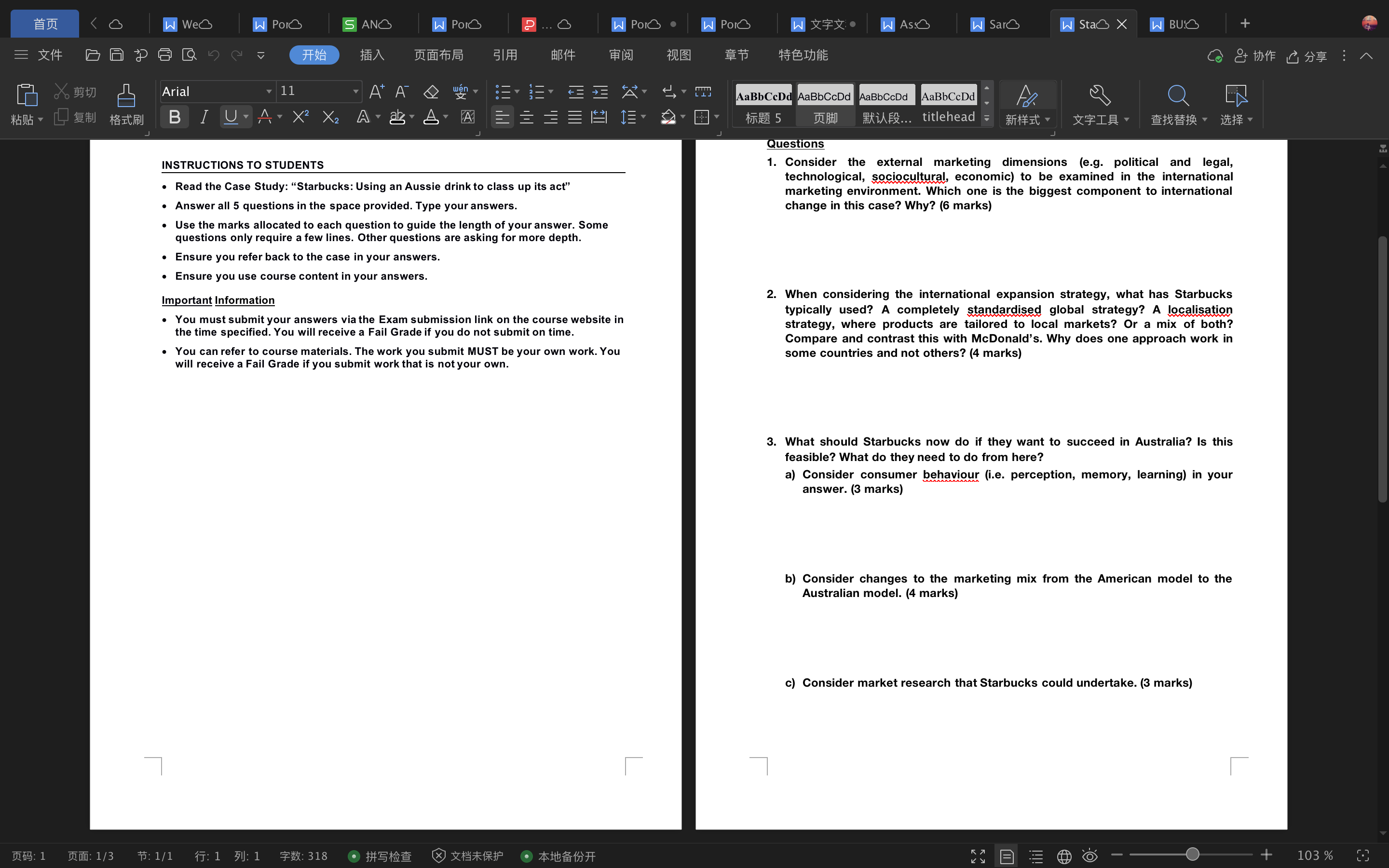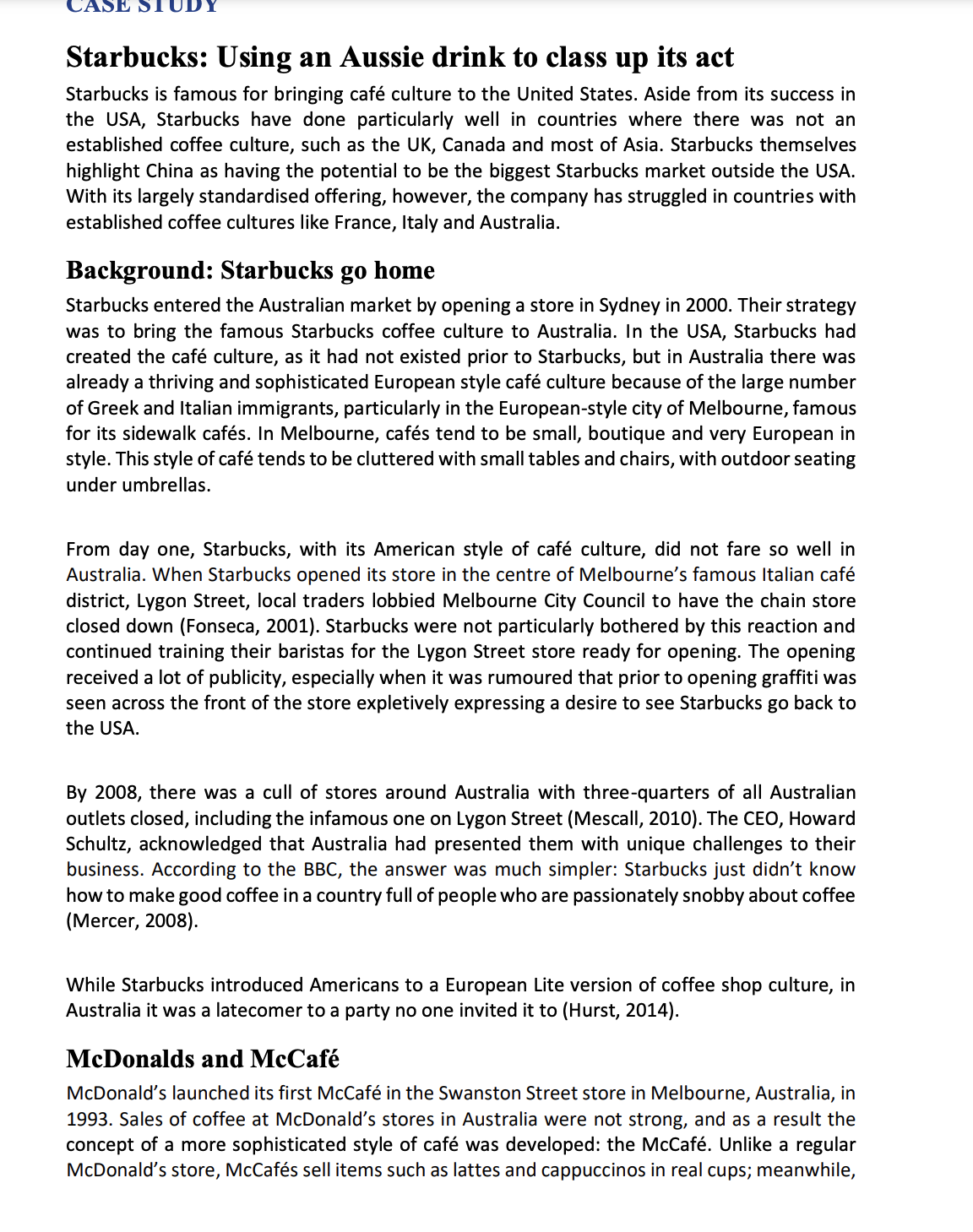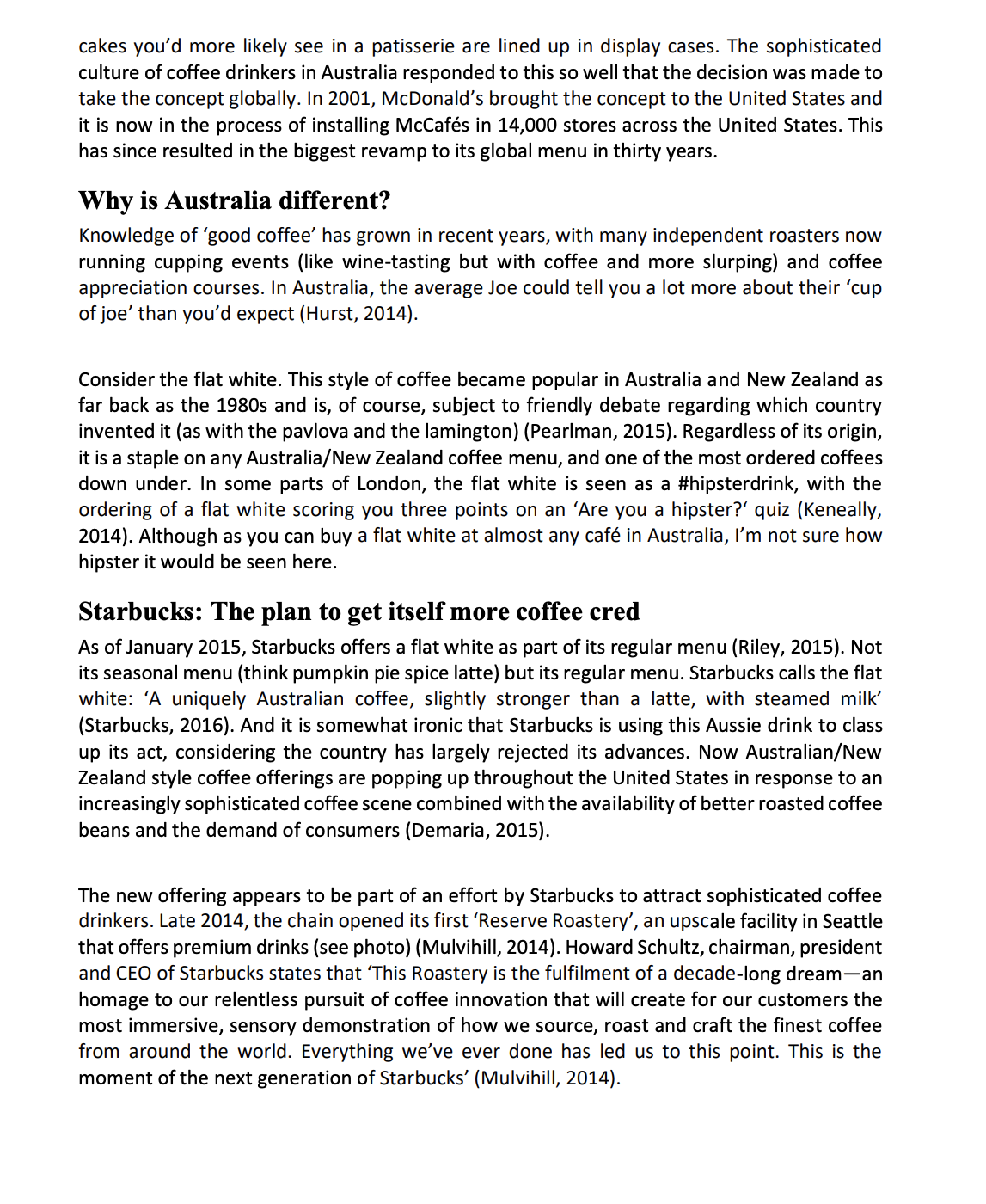1. Consider the external marketing dimensions (e.g. political and legal, technological,
sociocultural, economic) to be examined in the international marketing
environment. Which one is the biggest component to international change in this
case? Why?
2. When considering the international expansion strategy, what has Starbucks
typically used? A completely standardised global strategy? A localisation strategy,
where products are tailored to local markets? Or a mix of both? Compare and
contrast this with McDonald's. Why does one approach work in some countries
INSTRUCTIONS TO STUDENTS Read the Case Study: "Starbucks: Using an Aussie drinkto class up its act" Answer all 5 questions in the space provided. Type your answers. Use the marks allocated to each question to guide the length of your answer. Some questions only require a few lines. other questions are asking for more depth. Ensure you reler back to the case in your answers. Ensure you use course content in your answers. lmgonant Intonation I You must subm your answers via the Exam submission link on the course website in the time specied. You will receive a Fail Grade il you do not submit on time. 0 You can refer to course materials. The work you submit MUST be your own work. You will receive a Fail Grade If you submit work that Is not your own. i':ii ii" vi 1. Consider the external marketing dimensions (e.g. political and legal, technological, WW! economic) to be examined in the international marketing environment. which one is the biggest component to international change in this case? Why? (6 marks) When considering the international expansion strategy, what has Starbucks typically used? A completely WW global strategy? A Localisation stratng, where products are tailored to local markets? Or a mix of both? Compare and contrast this with McDonald's. Why does one approach work in some countries and not others? (4 marks) What should Starbucks now do if they want to succeed in Australia? Is this feasible? What do they need to do from here? a) Consider consumer behaviour (Le. perception, memory, learning) in your answer. (3 marks) b) Consider changes to the marketing mix from the American model to the Australian model. (4 marks) c) Consider market research that Starbucks could undertake. (3 marks) Starbucks: Using an Aussie drink to class up its act Starbucks is famous for bringing cafe culture to the United States. Aside from its success in the USA, Starbucks have done particularly well in countries where there was not an established coffee culture, such as the UK, Canada and most of Asia. Starbucks themselves highlight China as having the potential to be the biggest Starbucks market outside the USA. With its largely standardised offering, however, the company has struggled in countries with established coffee cultures like France, Italy and Australia. Background: Starbucks go home Starbucks entered the Australian market by opening a store in Sydney in 2000. Their strategy was to bring the famous Starbucks coffee culture to Australia. In the USA, Starbucks had created the cafe culture, as it had not existed prior to Starbucks, but in Australia there was already a thriving and sophisticated European style cafe culture because of the large number of Greek and Italian immigrants, particularly in the European-style city of Melbourne, famous for its sidewalk cafes. In Melbourne, cafes tend to be small, boutique and very European in style. This style of cafe tends to be cluttered with small tables and chairs, with outdoor seating under umbrellas. From day one, Starbucks, with its American style of cafe culture, did not fare so well in Australia. When Starbucks opened its store in the centre of Melbourne's famous Italian cafe district, Lygon Street, local traders lobbied Melbourne City Council to have the chain store closed down (Fonseca, 2001). Starbucks were not particularly bothered by this reaction and continued training their baristas for the Lygon Street store ready for opening. The opening received a lot of publicity, especially when it was rumoured that prior to opening graffiti was seen across the front of the store expletively expressing a desire to see Starbucks go back to the USA. By 2008, there was a cull of stores around Australia with three-quarters of all Australian outlets closed, including the infamous one on Lygon Street (Mescall, 2010). The CEO, Howard Schultz, acknowledged that Australia had presented them with unique challenges to their business. According to the BBC, the answer was much simpler: Starbucks just didn't know how to make good coffee in a country full of people who are passionately snobby about coffee (Mercer, 2008) While Starbucks introduced Americans to a European Lite version of coffee shop culture, in Australia it was a latecomer to a party no one invited it to (Hurst, 2014). Mcdonalds and McCafe Mcdonald's launched its first McCafe in the Swanston Street store in Melbourne, Australia, in 1993. Sales of coffee at Mcdonald's stores in Australia were not strong, and as a result the concept of a more sophisticated style of cafe was developed: the McCafe. Unlike a regular Mcdonald's store, McCafes sell items such as lattes and cappuccinos in real cups; meanwhile,cakes you'd more likely see in a patisserie are lined up in display cases. The sophisticated culture of coffee drinkers in Australia responded to this so well that the decision was made to take the concept globally. In 2001, McDonald's brought the concept to the United States and it is now in the process of installing McCafs in 14,000 stores across the United States. This has since resulted in the biggest revamp to its global menu in thirty years. Why is Australia different? Knowledge of \"good coffee' has grown in recent years, with many independent roasters now running cupping events (like wine-tasting but with coffee and more slurping) and coffee appreciation courses. In Australia, the average Joe could tell you a lot more about their 'cup of joe' than you'd expect (Hurst, 2014). Consider the flat white. This style of coffee became popular in Australia and New Zealand as far back as the 19805 and is, of course, subject to friendly debate regarding which country invented it (as with the pavlova and the lamington) (Pearlman, 2015). Regardless of its origin, it is a staple on any Australia/New Zealand coffee menu, and one of the most ordered coffees down under. In some parts of London, the flat white is seen as a #hipsterdrink, with the ordering of a flat white scoring you three points on an 'Are you a hipster?' quiz (Keneally, 2014). Although as you can buy a flat white at almost any caf in Australia, I'm not sure how hipster it would be seen here. Starbucks: The plan to get itself more coffee cred As of January 2015, Starbucks offers a flat white as part of its regular menu (Riley, 2015). Not its seasonal menu (think pumpkin pie spice latte) but its regular menu. Starbucks calls the flat white: 'A uniquely Australian coffee, slightly stronger than a latte, with steamed milk' (Starbucks, 2016). And it is somewhat ironic that Starbucks is using this Aussie drink to class up its act, considering the country has largely rejected its advances. Now Australian/New Zealand style coffee offerings are popping up throughout the United States in response to an increasingly sophisticated coffee scene combined with the availability of better roasted coffee beans and the demand of consumers (Demaria, 2015). The new offering appears to be part of an effort by Starbucks to attract sophisticated coffee drinkers. Late 2014, the chain opened its first 'Reserve Roastery', an upscale facility in Seattle that offers premium drinks (see photo) (Mulvihill, 2014). Howard Schultz, chairman, president and CEO of Starbucks states that 'This Roastery is the fulfilment of a decade-long dreaman homage to our relentless pursuit of coffee innovation that will create for our customers the most immersive, sensory demonstration of how we source, roast and craft the nest coffee from around the world. Everything we've ever done has led us to this point. This is the moment of the next generation of Starbucks' (Mulvihill, 2014)









